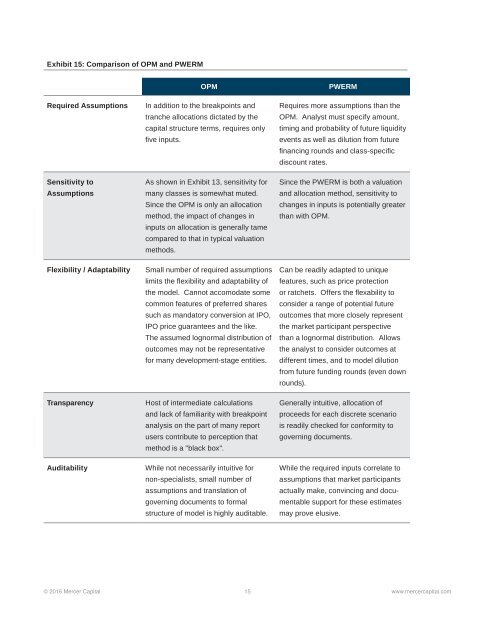A Layperson’s Guide to the Option Pricing Model
Article_Mercer-Capital-Guide-Option-Pricing-Model
Article_Mercer-Capital-Guide-Option-Pricing-Model
You also want an ePaper? Increase the reach of your titles
YUMPU automatically turns print PDFs into web optimized ePapers that Google loves.
Exhibit 15: Comparison of OPM and PWERM<br />
Required Assumptions<br />
Sensitivity <strong>to</strong><br />
Assumptions<br />
Flexibility / Adaptability<br />
Transparency<br />
Auditability<br />
OPM<br />
In addition <strong>to</strong> <strong>the</strong> breakpoints and<br />
tranche allocations dictated by <strong>the</strong><br />
capital structure terms, requires only<br />
five inputs.<br />
As shown in Exhibit 13, sensitivity for<br />
many classes is somewhat muted.<br />
Since <strong>the</strong> OPM is only an allocation<br />
method, <strong>the</strong> impact of changes in<br />
inputs on allocation is generally tame<br />
compared <strong>to</strong> that in typical valuation<br />
methods.<br />
Small number of required assumptions<br />
limits <strong>the</strong> flexibility and adaptability of<br />
<strong>the</strong> model. Cannot accomodate some<br />
common features of preferred shares<br />
such as manda<strong>to</strong>ry conversion at IPO,<br />
IPO price guarantees and <strong>the</strong> like.<br />
The assumed lognormal distribution of<br />
outcomes may not be representative<br />
for many development-stage entities.<br />
Host of intermediate calculations<br />
and lack of familiarity with breakpoint<br />
analysis on <strong>the</strong> part of many report<br />
users contribute <strong>to</strong> perception that<br />
method is a "black box".<br />
While not necessarily intuitive for<br />
non-specialists, small number of<br />
assumptions and translation of<br />
governing documents <strong>to</strong> formal<br />
structure of model is highly auditable.<br />
PWERM<br />
Requires more assumptions than <strong>the</strong><br />
OPM. Analyst must specify amount,<br />
timing and probability of future liquidity<br />
events as well as dilution from future<br />
financing rounds and class-specific<br />
discount rates.<br />
Since <strong>the</strong> PWERM is both a valuation<br />
and allocation method, sensitivity <strong>to</strong><br />
changes in inputs is potentially greater<br />
than with OPM.<br />
Can be readily adapted <strong>to</strong> unique<br />
features, such as price protection<br />
or ratchets. Offers <strong>the</strong> flexability <strong>to</strong><br />
consider a range of potential future<br />
outcomes that more closely represent<br />
<strong>the</strong> market participant perspective<br />
than a lognormal distribution. Allows<br />
<strong>the</strong> analyst <strong>to</strong> consider outcomes at<br />
different times, and <strong>to</strong> model dilution<br />
from future funding rounds (even down<br />
rounds).<br />
Generally intuitive, allocation of<br />
proceeds for each discrete scenario<br />
is readily checked for conformity <strong>to</strong><br />
governing documents.<br />
While <strong>the</strong> required inputs correlate <strong>to</strong><br />
assumptions that market participants<br />
actually make, convincing and documentable<br />
support for <strong>the</strong>se estimates<br />
may prove elusive.<br />
© 2016 Mercer Capital 15 www.mercercapital.com


